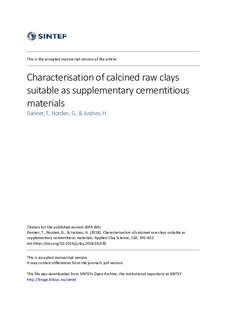Characterisation of calcined raw clays suitable as supplementary cementitious materials
Journal article, Peer reviewed
Accepted version

Permanent lenke
http://hdl.handle.net/11250/2581665Utgivelsesdato
2018Metadata
Vis full innførselSamlinger
- Publikasjoner fra CRIStin - SINTEF AS [5802]
- SINTEF Community [2248]
Sammendrag
The potential use of two raw clays (Clay A: kaolin; Clay B: calcareous montmorillonite) as supplementary cementitious material (SCM) in blended cements was investigated. Cement replacement in mortars by 20% calcined Clay A and Clay B resulted in a considerable 28 day compressive strength improvement. The pozzolanic reactivity of Clay A and B is explained by characterisation of the structural changes upon calcination with XRD, ICP-MS, FT-IR, 27Al NMR, Mössbauer spectroscopy and SEM. At the temperature giving highest pozzolanic reactivity, kaolinite and montmorillonite were completely dehydroxylated, while calcite from Clay B was not completely decomposed. FT-IR, 27Al NMR and Mössbauer spectroscopy revealed considerable structural deformations of kaolinite in Clay A and montmorillonite in Clay B resulting in an amorphous, reactive state. Oxidation of iron in Clay B during calcination contributed to strong distortions of the octahedral sheet in the montmorillonite structure. Additionally, the formation of a glass phase due to reaction of coccoliths (CaCO3) and montmorillonite was observed.
